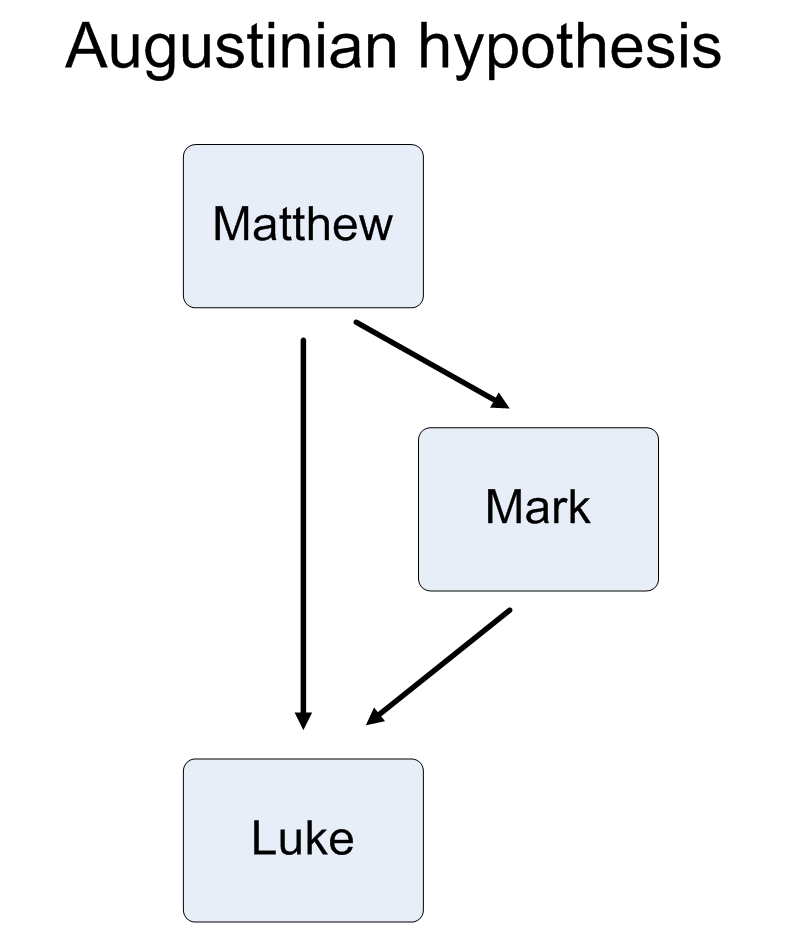You might as well start playing this now. Enjoy.
While we
have been reading through the Gospel of Mark over the past few classes, you may
have asked yourself why this book was chosen as part of the Canonical Gospels,
which also includes Matthew, Luke, and John (Waterworth, 1848). There are many
other gospels, or stories about the life of Jesus, that were written and
considered for inclusion, but denied canon during the Council of Trent. These
include the Gospels of Philip, Judas, Truth, and Perfection, to name a few (Koester,
1980). What makes the common four so important to be included in one of the
most widely read sacred texts?
The Synoptic Gospels, Matthew, Mark, and Luke, are so called because they “see together,” or have the same point of view. They definitely live up to that name; many of the events recorded in one are shared by the others, such as John the Baptist, Jesus’s baptism, Jesus’s temptation, various healings and parables, Peter’s confession (and denial), Jesus’s transfiguration, and the plot to kill Jesus (“The Order,” n.d.). Many scholars affirm there existed what is referred to as the mysterious “Q source.” This document and the Gospel of Mark are considered to be the material from which the other Synoptic Gospels drew (Lührmann, 1989).
The Synoptic Gospels, Matthew, Mark, and Luke, are so called because they “see together,” or have the same point of view. They definitely live up to that name; many of the events recorded in one are shared by the others, such as John the Baptist, Jesus’s baptism, Jesus’s temptation, various healings and parables, Peter’s confession (and denial), Jesus’s transfiguration, and the plot to kill Jesus (“The Order,” n.d.). Many scholars affirm there existed what is referred to as the mysterious “Q source.” This document and the Gospel of Mark are considered to be the material from which the other Synoptic Gospels drew (Lührmann, 1989).
The
Augustinian hypothesis claims, however, that the Gospel of Matthew was the
original source of material for the later Gospels of Mark and Luke. This
hypothesis also claims that Luke borrowed material from Mark (Thomas, 2002).
The Q source is completely ousted with this theory.
Another
theory that exists concerning the Synoptic Gospels is the Farrer hypothesis.
This claims that Mark was written first followed by Matthew. Luke then borrowed
from both of these (Farrer, 1955). With the shared styles and recorded events,
this claim boasts much regard.
Whichever
theory may be correct – or, none of them may be correct – the Gospel of John
still must be discussed. Why is this one different from the other three? The
authorship of John has been long disputed. Its writing style and wordage bears
much resemblance to the three epistles credited to John’s penmanship. Indeed,
the first chapters of both the Gospel and 1st John share very
similar wording about the manifestation of God as Jesus and calling Him the
Word and the Light.
When I have read through the
Gospels before, I felt a different undertone with John. John seemed to tell a
more evangelical and proselytizing story. That is to say, it was a more
awe-inspiring and persuasive one to me. It felt like John – or whoever the
author was – was trying to convert me. Phrases such as “eternal life” are
employed much more frequently. It’s also noteworthy that Jesus’s mother is
never mentioned throughout the whole book.
The Gospel of John largely owes its
inclusion in biblical canon to the work of Irenaeus. Irenaeus lived from 130 to
202 and was the disciple of Polycarp. Polycarp was a disciple of John (Richardson,
1953). So if John really was the author of his Gospel, it would make sense that
Irenaeus would endorse it fervently. Another thing Irenaeus did fervently was
fight Gnosticism, a school of thought that significantly downplayed Jesus’s
divinity (“Irenaeus, Bishop,” n.d.). As I’ve already mentioned, John’s Gospel
drives the idea home that Jesus is God is Jesus is God is Jesus. Of course,
those Gnostics would hate this idea, and Irenaeus could use it to dissuade
others from their heretical teaching. From then until today the Gospel of John
has held a place in the Bible along with Matthew, Mark, and Luke. All four of
them unite together to create an image of a man living in Israel who is
followed by millions of people still today.
 |
| Matthew, Mark, Luke, John... and the heart guy... |
[electronic image of Planeteers uniting in power to summon
the awesome Captain Planet]. Retrieved April 21, 2013, from: http://cragmama.com/wp-content/uploads//2012/06/ThePlaneteers.jpg
Farrer, A. (1955). On Dispensing With Q. Studies
in the Gospels: Essays in Memory of R. H. Lightfoot. Retrieved from http://www.markgoodacre.org/Q/farrer.htm
Irenaeus, Bishop of Lyons, Theologian. Retrieved from http://justus.anglican.org/resources/bio/194.html
[iSSerDc]. (2007, July 3). pachelbel's Canon in D--Soothing music(the best version) [video file]. Retrieved from https://www.youtube.com/watch?v=hOA-2hl1Vbc
Koester, H. (1980). Apocryphal and Canonical Gospels. The Harvard Theological Review, 73(1/2),
105-130.
Lührmann, D. (1989). The Gospel of Mark
and the Sayings Collection Q. Journal of
Biblical Literature, 108(1), 51-71.
McOnroy (designer).
(2007). The Two-source
Hypothesis to the synoptic problem [electronic image]. Retrieved April 21,
2013, from: http://en.wikipedia.org/wiki/File:Synoptic_problem_two_source_colored.png
McOnroy (designer).
(2007). The Augustinian hypothesis solution to the Synoptic problem [electronic
image]. Retrieved April 21, 2013, from: http://en.wikipedia.org/wiki/File:Synoptic_problem_-_Augustinian_hypothesis.png
McOnroy (designer).
(2007). Farrer hypothesis solution of the synoptic problem [electronic image].
Retrieved April 21, 2013, from: http://en.wikipedia.org/wiki/File:Synoptic_problem_Farrer_hypothesis_.png
Richardson, C. (1953). Early
Christian Fathers. Louisville: Westminster John Knox Press.
The Order of the Triple Tradition in the Synoptic Gospels.
Retrieved from http://www.mycrandall.ca/courses/ntintro/OrderTriple.htm
Thomas, R. (2002). Three views on the origins of the Synoptic
Gospels. Grand Rapids: Kregel Academic &
Professional.
Waterworth, J. (1848). Canons
and Decrees of the Council of Trent. London.



No comments:
Post a Comment